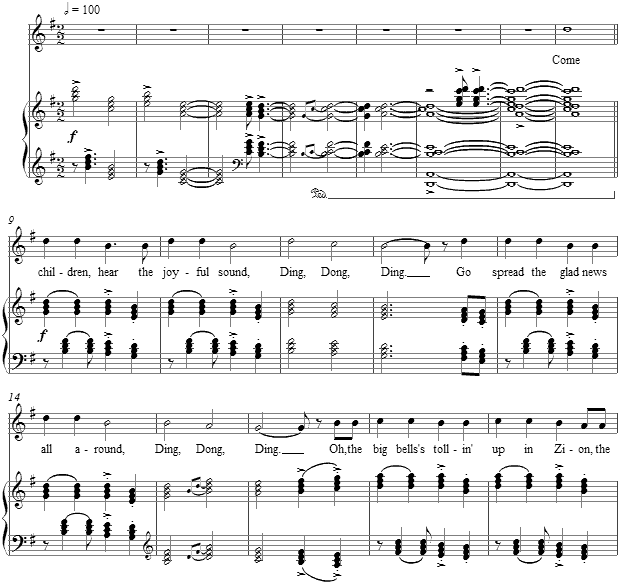Music and Texts of GARY BACHLUND
Vocal Music | Piano | Organ | Chamber Music | Orchestral | Articles and Commentary | Poems and Stories | Miscellany | FAQs
The Big Bell in Zion - (2008)
Theodore Henry Shackelford
for high voice and piano
Come, children, hear the joyful sound,
Ding, Dong, Ding.
Go spread the glad news all around,
Ding, Dong, Ding.
Chorus
Oh, the big bell's tollin' up in Zion,
The big bell's tollin' up in Zion,
The big bell's tollin' up in Zion,
Ding, Dong, Ding.
I've been abused and tossed about,
Ding, Dong, Ding.
But glory to the Lamb, I shout!
Ding, Dong, Ding.
My bruthah jus' sent word to me,
Ding, Dong, Ding.
That he'd done set his own self free.
Ding, Dong, Ding.
Ole massa said he could not go,
Ding, Dong, Ding.
But he's done reached Ohio sho'.
Ding, Dong, Ding.
Ise gwine to be real nice an' meek,
Ding, Dong, Ding.
Den I'll run away myself nex' week.
Ding, Dong, Ding.
Chorus
Oh, the big bell's tollin' up in Zion,
The big bell's tollin' up in Zion,
The big bell's tollin' up in Zion,
Ding, Dong Ding.[ 6 pages, circa 2' 45" ]
The 1922 edition cover
According to James Weldon Johnson's minimal notes in The Book of American Negro Poetry, Theodore Henry Shackelford was author "of Mammy's Cracklin' Bread and Other Poems, and My Country and Other Poems." This text is the only example of Shackelford's verse in the Johnson anthology, and sadly little other information or other texts are available on line at this time. As with many of the texts which Johnson collected and himself penned, this too is written to capture the regional flavor of the dialect spoken. "Ise gwine," for example, is "I is going," with the incorrect grammar melded into a contraction" and "massa" is "master."
The setting is joyous, as the singer imagines freedom from the confines of slavery. Throughout history, the subject of coming to freedom out of slavery contains among its elements the notion of anticipation and excitement. As Shackelford's poem is presented as verses with a refrain, I chose to break apart the refrain and present it in varied shortened forms between the verses, such that the setting is no longer a repetitive verse-and-chorus form, but something akin to it yet irregular. The accompaniment therefore is meant to be bell-like, not one "big bell" but many. The "charge" to the children and all of us as listeners is to "hear the joyful sound" of freedom. Throughout, parallel triads combine into seven chords, most often in first inversion.
After the several storytelling verses including information about the escape to freedom of the "bruthah," the poet/singer tells the ultimate point of this poem -- a plan for escape which includes the subterfuge of meekness. A lessening tempo and quieter dynamics make intent to share this secret with the audience.
The reprise of the opening of the song in Shackelford's "chorus" is its ending as well, with a short coda for the piano. At the opening and ending is the chorus presented in its exact textual repetition. Else, there are truncated versions thereof.
The score for The Big Bell in Zion is available as a free PDF download, though any major commercial performance or recording of the work is prohibited without prior arrangement with the composer. Click on the graphic below for this piano-vocal score.


